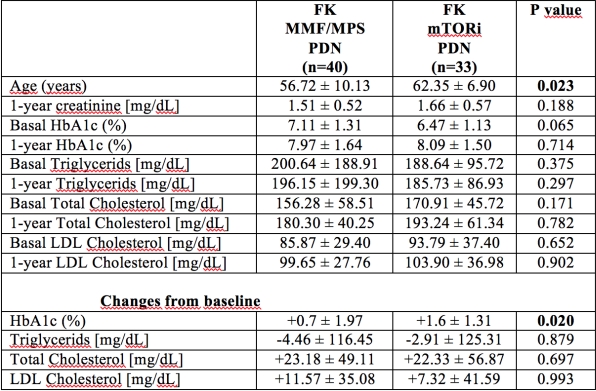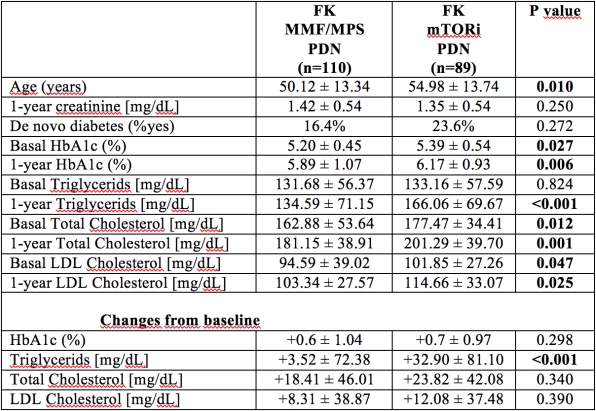Influence of mTOR Inhibitors on Metabolic Outcomes One Year after Kidney Transplantation: The Role of Pre-Transplantation Diabetes
D. Cucchiari,1 S. Karam,2 P. Ventura-Aguiar,1 J. Torregrosa,1 F. Diekmann.1
1Renal Transplant Unit, Hospital Clínic, Barcelona, Spain
2Department of Medicine, Saint George Hospital, Beirut, Lebanon.
Meeting: 2018 American Transplant Congress
Abstract number: A222
Keywords: Drug interaction, Dyslipidemia, Immunosuppression, Post-transplant diabetes
Session Information
Session Name: Poster Session A: Kidney: Cardiovascular and Metabolic
Session Type: Poster Session
Date: Saturday, June 2, 2018
Session Time: 5:30pm-7:30pm
 Presentation Time: 5:30pm-7:30pm
Presentation Time: 5:30pm-7:30pm
Location: Hall 4EF
INTRODUCTION: mTOR inhibitors alter lipids and carbohydrate metabolism in kidney transplant recipients. Little is known if there is any difference between patients who were already diabetics or not before transplantation.
METHODS: longitudinal 1-year long study in which we compared two different regimens based on tacrolimus and prednisone, one with mycophenolate (MP group) and one with a mTOR inhibitor (sirolimus/everolimus, mTORi group). The studied population included kidney transplant patients from June 2013 to May 2016 (n=272).
RESULTS: considering the whole population, the mTORi group had significant higher increase in HbA1c and triglycerides compared to MP group 1 year after transplant (MP +0.66 ± 1.38% vs mTORi +0.98 ± 1.13%, p=0.017 for HbA1c and MP +1.42 ± 85.83mg/dl vs mTORi +23.21 ± 95.87mg/dl, p= 0.003 for triglycerides).
When considering only diabetic patients at baseline (n=73), the increase in HbA1c was much more pronounced in mTORi group (MP group +0.7 ± 1.97% vs mTORi group +1.6 ± 1.31, p=0.020), while there was not any change in triglycerides between groups (p=0.879). 
On the contrary, patients without diabetes at baseline (n=199) had a significant increase in triglycerides (MP +1.42 ± 85.83 mg/dl vs mTORi +23.21 ± 95.87 mg/dl, p=0.003), while no difference was observed in HbA1c (p=0.298). There was no difference in the incidence of de-novo diabetes after transplant between groups (p=0.272). 
CONCLUSIONS: the change in HbA1c was mainly observed only in mTORi patients who were already diabetics before transplantation and there is not an increase in the incidence of de-novo diabetes in this group. Curiously, the increase in triglycerides was observed only in patients who were not diabetics before transplantation.
CITATION INFORMATION: Cucchiari D., Karam S., Ventura-Aguiar P., Torregrosa J., Diekmann F. Influence of mTOR Inhibitors on Metabolic Outcomes One Year after Kidney Transplantation: The Role of Pre-Transplantation Diabetes Am J Transplant. 2017;17 (suppl 3).
To cite this abstract in AMA style:
Cucchiari D, Karam S, Ventura-Aguiar P, Torregrosa J, Diekmann F. Influence of mTOR Inhibitors on Metabolic Outcomes One Year after Kidney Transplantation: The Role of Pre-Transplantation Diabetes [abstract]. https://atcmeetingabstracts.com/abstract/influence-of-mtor-inhibitors-on-metabolic-outcomes-one-year-after-kidney-transplantation-the-role-of-pre-transplantation-diabetes/. Accessed December 16, 2025.« Back to 2018 American Transplant Congress
